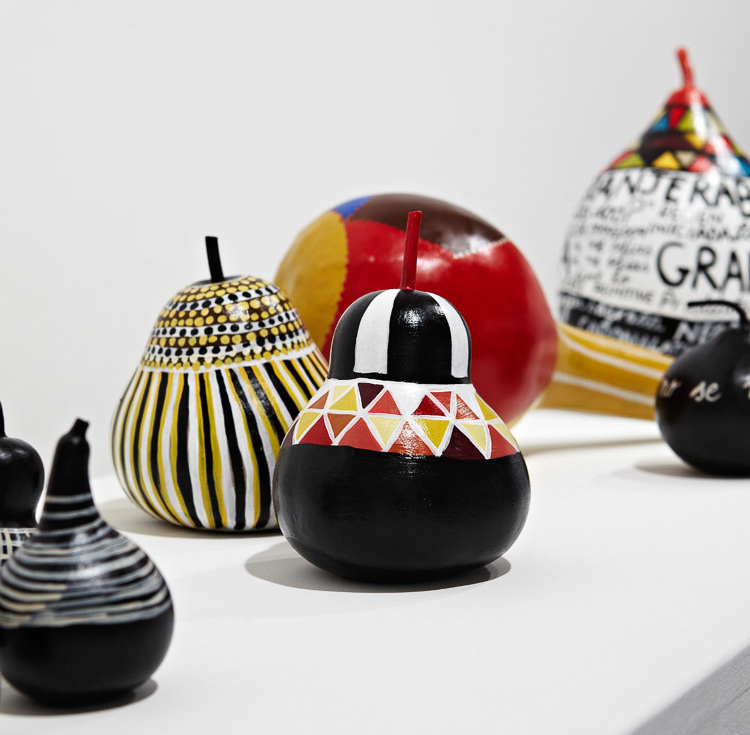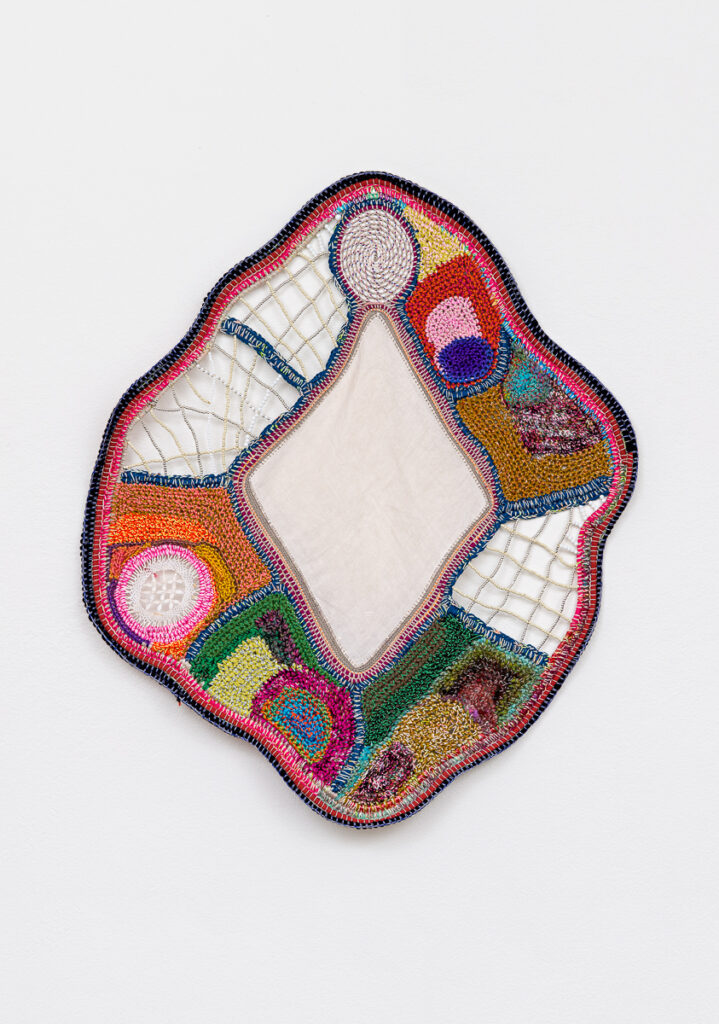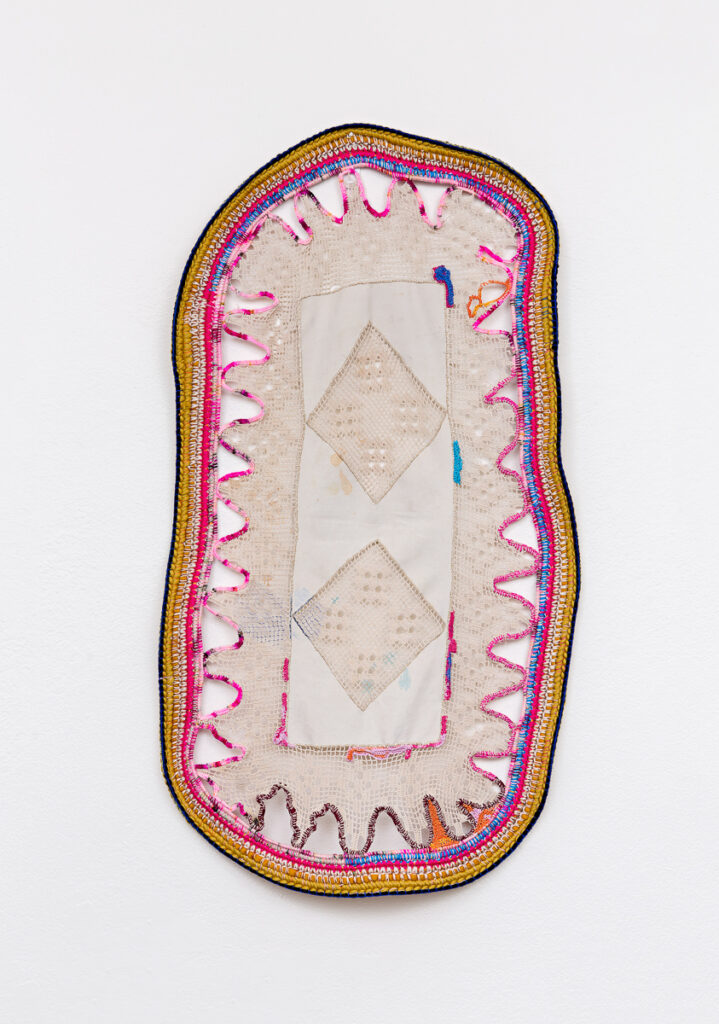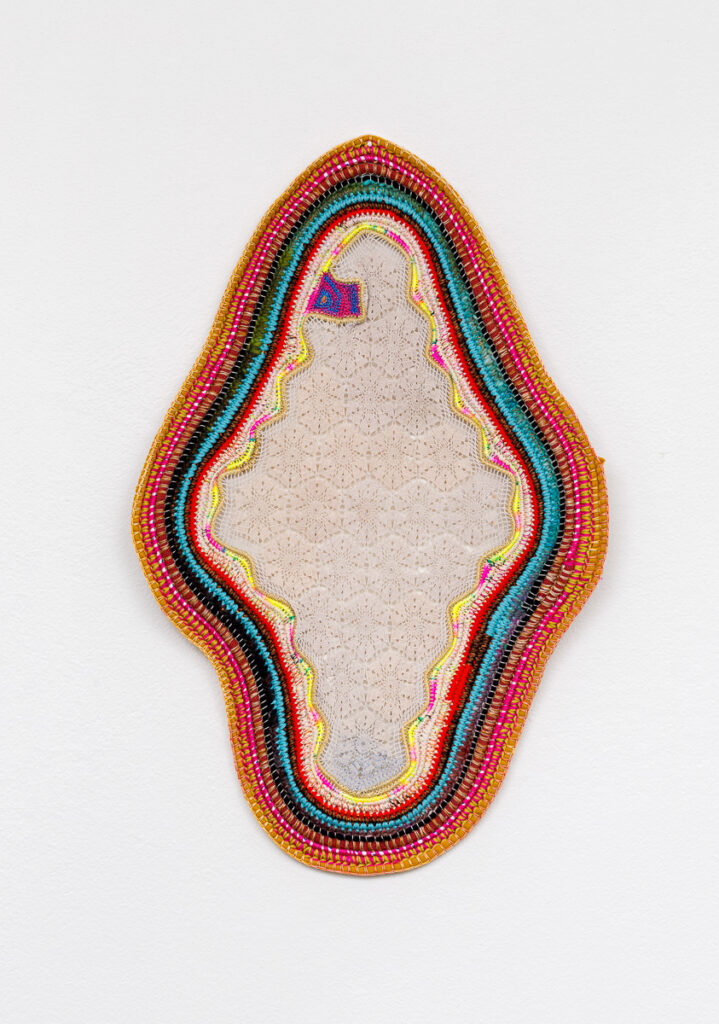Paula do Prado shares the story of her family’s epic story from Africa via Uruguay to Australia, as reflected in her intricately threaded creations.
What is your family story?
My family story is still unfolding and revealing itself. It’s complex and made up of multiple narratives. I am one of the family archivists and genealogical researchers: where we came from, why we moved, why we stayed and what were the events that impacted on those decisions. I know that our family story is one of movement, by force, necessity and desire. It is the story of North and South America, Western Europe and the Bantu speaking people of West, Central and South Africa…that means we’ve covered a lot of ground and sea.
Can you describe your family’s move from Uruguay to Australia?
It was such a line in the sand moment and it’s hard to pinpoint exactly when my parents decided to leave Uruguay, get on the plane, land in Sydney or stay. My parents and I migrated to Australia in September 1986. I was seven years old. My mother’s brother, my uncle Nelson, had sponsored our visas under the then Family Reunion scheme that I think ended the year after we migrated. My dad had actually come to Sydney on his own a couple of years prior in 1984. My dad is a musician and he came to perform for a solidarity concert for Nicaragua at the Sydney Town Hall. It’s funny, I did an artwork about our move to Australian in 2009, titled “A Big Adventure” because to me it really was an exciting and wondrous time, at first anyway. For my parents, I can only imagine it was a stressful time of uncertainty. In my artist statement I wrote;
“Looking back, I realise that our coming to Australia, that moment, that first flight changed my life forever. I feel immensely indebted to my parents for making such a brave decision. People say migration is not for everyone. The first few years in Australia were very difficult. My dad used to ride a bike to work wearing plastic bags over his shoes to protect them from the rain. Mum struggled to get to English lessons because I didn’t want her to leave me. We often received long letters on lined paper or taped messages from our family overseas and we would sit together reading news from home. It was very expensive to talk on the phone so these letters and tapes were our only link to family back home”
Neither the weight of what and why we had left nor the reality of the situation we had come into became clearer until much later. We had left a Uruguay that was still transitioning after the end of a military dictatorship which had pursued, harassed, captured, questioned and scarred both sides of my family including my parents directly. It’s only now I appreciate that the lyrics to my father’s songs were written in a kind of poetic code so as not to fully reveal their politics. And so there we were and here we are, seeking liberation from an oppressive political, social and economic climate only to find ourselves settling on stolen land where Indigenous Australians were (and continue to) experiencing horrendous and other more covert forms of oppression.
How did you develop textiles as an art material?
I don’t remember ever not working with cloth or fibre in some way shape or form. Up until the age of seven I grew up very close to one of my mother’s sisters, my aunty, tia Tere. She would knit me jumpers and I remember sometimes a few of the aunts and cousins would gather to knit or make.
Old t-shirts and jumpers would be repurposed as cleaning cloths. They would also make little cloth bags for keepsakes or for presents.
I was adept with the “big scissors” from a young age and would also sew dolls clothes by hand. I think that manual dexterity and using our hands to make and transform things is something deeply embedded in my maternal line.
I reconnected with textiles when I went back to university to study Fine Art after having spent nearly ten years studying and working in completely different fields. I’ve been on that journey of returning and remembering with my hands since. Initially, I thought I wanted to be a mixed media painter and then gradually I became more interested in taking the mixed media off the canvas or frame. I was then very fortunate to be taught and mentored by artist and educator Nicole Barakat who not only re-introduced me to textile techniques like hand and machine stitching but also to artists like Coco Fusco, Mona Hatoum and Doris Salcedo as well as the quilts of Gee’s Bend and writers like Gloria Anzaldúa.
So instead of choosing painting for my Bachelor of Fine Arts studies, I majored in Textiles which was then under the fine arts program as a separate stream to design. Even though my practice has become increasingly focussed on the use of crochet and coiling, I’m still exploring some of the questions and ideas to have come from those foundational years studying textiles. Namely, I’m still excited by the fact that what we consider to be a textile or art material for that matter is being continuously redefined.
While some of your work in the early exhibitions at Gallery Smith were text-based, you started to develop more sculptural forms. Were these based on any pre-existing form, or just the result of experimentation?
On reflection, I feel like the sculptural forms came out of looking at my own body, its shape and contours that felt so out of place because I didn’t see myself reflected anywhere. Moving into more sculptural forms was really a way of exploring my body and its place without making a direct or literal reference to it. That developed in a few different ways and included making doll-like fabric sculptures, painting on gourds and making gourd-like objects using the technique that I focus on currently that combines crochet and coiling.
Back at that moment when I started to develop more sculptural forms, it did feel like these elements were developing out of experimentation. I was really driven by how could I push things further, how can I do something different, how can I translate and bring in these things that show who I am and where I’m from. Now I see all of that process as part of wanting to remember the places and people I came from. So what might have appeared as experimentation was very much rooted in ancestral connection and that’s a relatively new revelation for me.
In particular, working with the gourds and using kapok as stuffing are two ancestral plant connections that continue to be important in my life/practice. The gourds are related to the Indigenous Tupi Guarani drink maté that is a very popular drink in Uruguay and other parts of South America. Maté is like a green tea made from yerba maté leaves steeped in hot water and traditionally drunk from a hollowed-out gourd/calabash with a metal straw/sieve. And kapok, which I didn’t know at the time, comes from the ceiba tree which has a significant place in Maya culture as axis mundi and in stories of connection between Latin America and Africa.
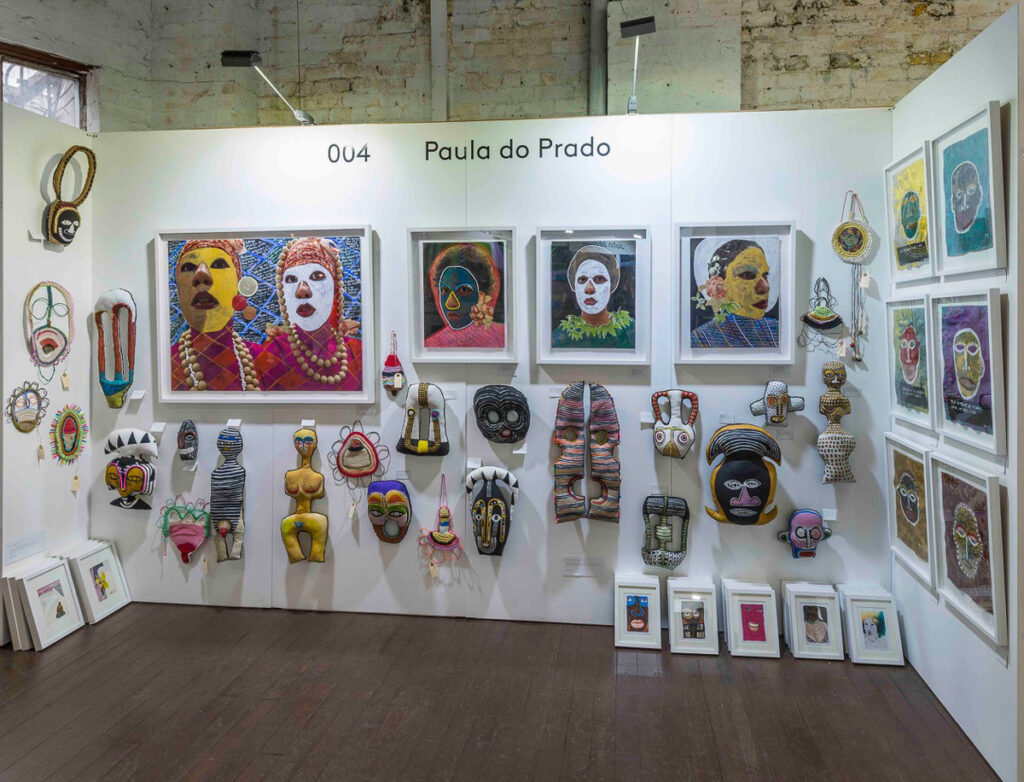
The Other Art Fair 2016, the first time exhibiting the smaller hybrid forms alongside soft sculpture and photo-media work.
How did the hybrid forms evolve?
The hybrid forms started off as samples. They were small studies combining crochet, coiling and taking older pre-made work which I would then deconstruct and reconfigure. I was really taken by being able to use this crochet technique as a way to join, combine and bring together different forms. Conceptually I was thinking about how I had come to really dislike using the terms mixed-race or biracial and even terms that were common from back home like “cafe con leche”.
I was frustrated by language and its limitations. I started to use the term hybrid for my work because I wanted to make reference to these in-between, imaginary and also real spaces where its not “this or that” but both/and feminine and masculine, animal, plant, element, human. The materials I was using were also a combination of natural and non-natural, traditional and non-traditional. As the forms developed I also started sourcing more specific materials such as açai seeds, hand-spun and dyed yarns, glass beads that were sometimes expensive and difficult to source and I was using these alongside cheap acrylic, plastic beads and poly string.
The hybrid forms have just continued to evolve. More recently the works are becoming larger scale, beaded elements continue to feature to a lesser extent in preference for other stitched and bound embellishments. The forms that emerge are unplanned and reveal themselves in the moment of making and sometimes even much later.
For me personally, I often see both inside and outside representations of the body such reproductive organs, faces, bodies, cells, neural networks and ribcages. I also often feel recurring animals appear such as owls, octopi, jellyfish, turtles, birds and all of these combine with plants, roots, spiral motifs and aerial views of land and bodies of water/sky.
✿
Selected works from the exhibition Iyanla at Shoalhaven Regional Gallery Nowra, NSW, Australia (7 – 28 September 2019)
Iyanla in the West African Yoruba language means great ancestral mother
Guidaí / Moon
Guidaí is the Charrúa word for moon. The Charrúa are one of the indigenous groups known to have inhabited large parts of Uruguay together with other groups of indigenous people including the Guaraní, Güenoa, Chaná, Bohán, Arachán, Minuane and Yaro before colonisation by the Portuguese and Spanish. Guida in Italian and guiar in Spanish means “to guide”.
Recently my dad to told me a story, that his father Fermin had told him. Fermin worked as a farmhand in Artigas as a young boy. He would often have to go and rescue a stray lamb out in a large farm field in pitch darkness with the only the moon as his guide back to the barn.
This work references a large web, an alluring but messy patchwork, irregular, twisted, warped, with various large gaps and a yawning blank centre with tiny near invisible holes between the warp and weft. The diamond shape is a recurring symbol in my work. The word diamond originates from Greek adamas, adamant-, “untameable, invincible” (later used to denote the hardest metal or stone, hence diamond), from a- “not” + daman “to tame”.
I often think on the complex intersections between our family history, the history of colonial genocide and ongoing oppression present in our lands of “origin” and where we came to seek a better life.
Alimentar / Nourish
I remember this table runner on the table at my paternal grandparents home. They are the only grandparents I got to know, both my mother’s parents had already passed away by the time I was born. My grandparents, mis abuelos, their names are Fermin do Prado Canabarro and Elsa Britos da Rosa. I remember as a small child when we lived in Uruguay, we would go to my grandparents for lunch most weekends. There would always be other family, aunts, uncles, cousins, second cousins, extended family and friends. I know now we used to go there partly out of necessity. Abuela’s cooking is legendary, not just because it was always tasty but because somehow magically she would feed everyone.
On one of my trips back to Uruguay over 15 years after we had migrated to Australia, Elsa gifted me this textile along with a few others. I had explained to my family that I was studying to be an artist and that I liked to work with cloth because it could hold stories, history and so much more.
After moving to Montevideo from Artigas in the 1950s my grandparents lived in Cordón a well known poor black neighbourhood. Despite having five children of their own Elsa and Fermin were well known for welcoming school friends to their dinner table, giving them a meal and help with study.
Heridas / Wounds
My father, Jorge do Prado is a singer/songwriter amongst other things. I titled this work after one of my favourite songs of his “Los Sueños y la vida”/Life and Dreams. I think one day I’ll get some of the lyrics tattooed on my body.
For me, the song speaks to what I heard Rev Angel Kyodo Williams say about love, that love brings suffering and pain. That our path is to hold the complexity of both love and pain and not try and give up either one.
The central textile piece is another gifted textile from my father’s mother, Elsa. My dad was born a few months after abuela Elsa lost her mother, Ana-Corina. How does the body register something like this? How is it passed on, how does it alter our code and for how long does it remain encoded?
Zita / Nudo / Knot
I started to crochet in April 2010, my mum taught me basic chain stitch and that’s still the only stitch I know. I experimented with crochet for a few years whilst continuing to work in self-portraiture, painting and fabric collage. It wasn’t until August 2016 that I first started making in this current way, combining crochet and coiling using paper covered floristry wire. The works started off quite small with only a few beaded details and I remember when I exhibited them publicly for the first time that year, and to help explain what they were, I had named them Hybrid Forms.
A few months ago I sought guidance via a divination session with Negarra A. Kudumu who holds the title of Yayi Nkisi Malongo in the Brama Con Brama lineage of Palo Mayombe. The session was enlightening and continues to provide a supportive basis in my exploration of diasporic African traditions and their connection to me and my work. I subsequently came across a dissertation written by Donato Fhunsu who refers to the work of Congolese philosopher Valentin Yves Mudimbe and the metaphor of the espace metissé or hybrid space. Fhunsu considers the hybrid space to be a “complex, contested, and thus dynamic space existing in constant political, philosophical, historical, geographical, psychological, and sociocultural tension as it constantly seeks to integrate, in the same “space-ness,” the past, the present, and the future of various constituent geographies and cosmologies”
Most significant to me was that he went on to relate hybrid space to a knot or zita in Kikongo, that acts “as a dynamic gate or bridge of powers, energies, or forces, a zita can be purposefully and consciously locked, tied [kukanga] or unlocked, untied [kukutula]”
As above so below. I have begun to understand the connectedness of all things and that the law of correspondence is indeed in full effect.

These are my abuela Elsa’s hands caught in a moment when she is showing me finger knitting that she learnt from my then six-year-old twin cousins, Aitor and Eneko. Elsa will be 97 years old at the end of September, she is currently in Germany on holiday spending time with Aitor and Eneko who are now 17 years old. Intergenerational knowledge sharing looks like the branches and roots of a tree.
All artwork images by Document Photography.
Artist
Paula Gabriela do Prado was born in 1979 on Charrúa land (Montevideo) in Uruguay. Her full name is Paula Gabriela do Prado Martirena Britos Castro. She is of African, Basque and Catalan descent, both sides of her family have lived and worked in Uruguay (including Minas, Montevideo and Artigas) for at least 3 generations. She migrated to Australia in 1986 with her parents. Her practice is predominantly textile-based but also includes self-portraiture, painting and objects. Her most recent works weave together intergenerational experiences and ancestral research as a form of self-healing.
do Prado holds a Bachelor of Fine Arts (Textiles) with First Class Honours and a Master of Fine Arts from the University of New South Wales Art & Design. She recently exhibited her work as part of the Blacktown City Art Prize 2018 and her entry “Manifest” was acquired by the Ford Land Company. In 2019, for the second year running she has been awarded an Artist Studio Residency from Woollahra Municipal Council. Her work is currently being exhibited at the Rijswijk Textile Biennial in the Netherlands and her work will be included in the upcoming group exhibition “Place Makers” at The Australian Tapestry Workshop in Naarm (Melbourne).
Follow @pauladopradomartirena.



